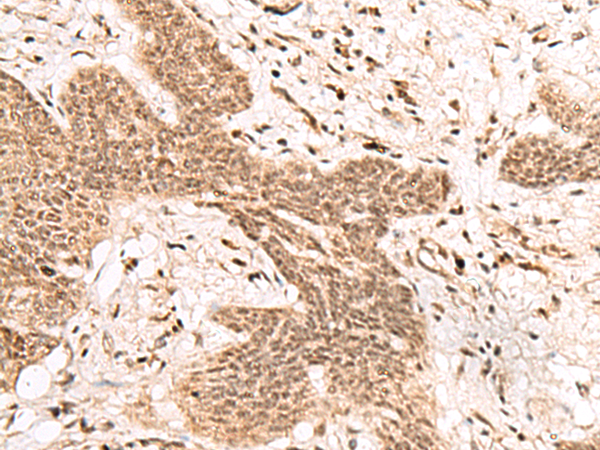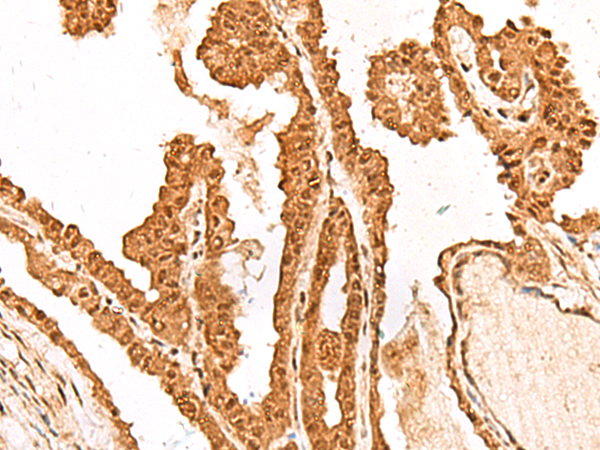

| WB | 咨询技术 | Human,Mouse,Rat |
| IF | 咨询技术 | Human,Mouse,Rat |
| IHC | 1/50-1/300 | Human,Mouse,Rat |
| ICC | 技术咨询 | Human,Mouse,Rat |
| FCM | 咨询技术 | Human,Mouse,Rat |
| Elisa | 1/5000-1/10000 | Human,Mouse,Rat |
| Aliases | CANP; POIKTMP |
| Host/Isotype | Rabbit IgG |
| Antibody Type | Primary antibody |
| Storage | Store at 4°C short term. Aliquot and store at -20°C long term. Avoid freeze/thaw cycles. |
| Species Reactivity | Human |
| Immunogen | Synthetic peptide of human FAM111B |
| Formulation | Purified antibody in PBS with 0.05% sodium azide and 50% glycerol. |
+ +
以下是几篇关于FAM111B抗体的模拟参考文献示例(注:以下内容为假设性示例,实际文献请通过学术数据库检索):
1. **文献名称**:*FAM111B expression correlates with pancreatic cancer progression and serves as a prognostic biomarker*
**作者**:Smith A, et al.
**摘要**:本研究通过免疫组化(使用FAM111B特异性抗体)分析胰腺癌组织中FAM111B蛋白的表达水平,发现其高表达与患者预后不良相关,提示FAM111B可能作为潜在治疗靶点。
2. **文献名称**:*FAM111B regulates DNA replication stress response via interaction with PCNA*
**作者**:Zhang Y, et al.
**摘要**:利用FAM111B抗体进行Co-IP和Western blot实验,发现FAM111B通过结合PCNA蛋白调控DNA复制应激反应,缺失会导致基因组不稳定性增加。
3. **文献名称**:*A novel FAM111B mutation linked to hereditary fibrosing poikiloderma*
**作者**:Johnson R, et al.
**摘要**:通过基因测序和免疫荧光(使用FAM111B抗体)发现,FAM111B基因突变导致其蛋白在皮肤成纤维细胞中异常聚集,与遗传性纤维化性皮肤异色症发病机制相关。
4. **文献名称**:*FAM111B promotes hepatocellular carcinoma metastasis via Wnt/β-catenin pathway activation*
**作者**:Li X, et al.
**摘要**:在肝癌细胞系中,通过shRNA敲低FAM111B并结合抗体检测蛋白表达,证实FAM111B通过激活Wnt通路促进肿瘤侵袭转移。
建议通过PubMed、Google Scholar等平台检索真实文献,关键词:"FAM111B antibody"、"FAM111B function"等。
FAM111B antibody is a research tool used to study the FAM111B protein, encoded by the FAM111B gene located on human chromosome 11q12.1. FAM111B is a nuclear protein implicated in DNA repair, cell proliferation, and apoptosis regulation. Its functional roles remain incompletely understood, but studies suggest interactions with proliferating cell nuclear antigen (PCNA) and potential involvement in proteasome-mediated degradation pathways. Mutations in FAM111B are linked to hereditary fibrosing poikiloderma (HNFJ), a rare autosomal dominant disorder characterized by skin abnormalities, fibrosis, and increased cancer risk. Dysregulated FAM111B expression has also been observed in cancers, including pancreatic, hepatocellular, and cervical carcinomas, where overexpression correlates with poor prognosis.
FAM111B antibodies are primarily used in Western blotting, immunohistochemistry, and immunofluorescence to detect protein expression patterns, subcellular localization, and disease-associated alterations. Structural studies predict FAM111B contains a trypsin-like protease domain and a nuclear localization signal, though its enzymatic activity remains unconfirmed. Pathogenic HNFJ-associated mutations (e.g., p.Ser342Ala) may disrupt DNA repair mechanisms, contributing to genomic instability. Research continues to explore FAM111B's molecular interactions, its role in cancer progression, and its potential as a diagnostic or therapeutic target. Commercial antibodies vary in specificity, requiring validation via knockout controls to ensure reliability in experimental models.
×